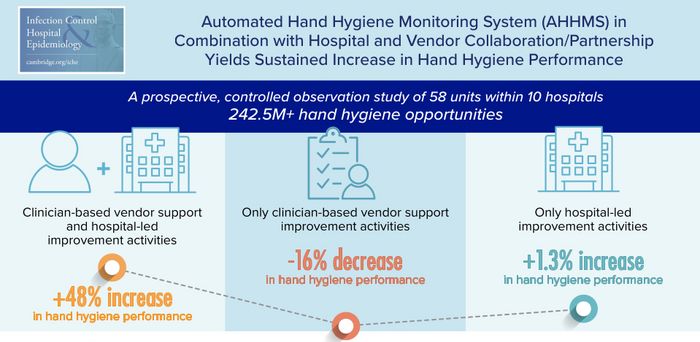A new study, recently published in the journal Infection Control and Hospital Epidemiology, demonstrates healthcare facilities that actively partner with their automated hand hygiene monitoring system (AHHMS) vendor are able to achieve greater improvement in hand hygiene performance – a backbone of infection control programs. The study was conducted by researchers at GOJO Industries.
“With data from 58 units in 10 hospitals throughout North America – 243 million hand hygiene opportunities – this study makes an important contribution to understanding hand hygiene performance-rate improvement efforts,” said Jim Arbogast, PhD, the lead author of the study and vice president of hygiene sciences and public health advancements at GOJO Industries. “The evidence is clear that clinician-based support from their AHHMS vendor is a critical component that hospitals can’t overlook in their hand hygiene performance efforts. Healthcare facilities shouldn’t install an AHHMS and forget about it.”
The study, "The impact of automated hand hygiene monitoring with and without complementary improvement strategies on performance rates," was published online on August 22 in ICHE. Hand hygiene performance rates were estimated using the PURELL Smartlink® Activity Monitoring System and showed greater sustained increases in hand hygiene performance when the hospital worked in collaboration with the vendor to implement the system and initiate complementary improvement interventions. Major findings of the study include:
AHHMS in combination with clinician-based vendor support and hospital-led unit-based initiatives (Vendor + Hospital group) led to statistically significant improvements in hand hygiene performance compared with the Vendor-only, Hospital-only, or AHHMS-alone groups (>46% increase; P < 0.006). 1
Hospital units in the Vendor-plus-Hospital group achieved a 76% increase in hand hygiene performance compared to the Vendor-only group (46.9/26.7=1.76), a 46% increase compared to the Hospital-only group (46.9/32.1=1.46), and a 48% increase over the AHHMS-alone group (46.9/31.7=1.48). 1
"This multi-year study of multiple healthcare facilities is crucial for understanding hand hygiene because, unlike single facility studies, it directly assesses how reproducible hand hygiene rates are. I am unaware of any other multi-facility trial of this size in the literature,” said co-author Albert Parker, biostatistician at the Center for Biofilm Engineering and research professor, Montana State University.
These findings were originally accepted as a poster at the Society for Healthcare Epidemiology of America (SHEA) Decennial conference in 2020. 2
References:
1. Arbogast, J.W., Moore, L.D., DiGiorgio, M., Robbins, G., Clark, T. L., Thompson, M. F., Wagner, P. T., Boyce, J. M., Parker, A. E. The impact of automated hand hygiene monitoring with and without complementary improvement strategies on performance rates. Infect Control Hosp Epidemiol. Published online August 22, 2022. doi:10.1017/ice.2022.141
2. Arbogast, J., Moore, L., DiGiorgio, M., Boyce, J., & Parker, A. (2020). The Effect of Automated Hand Hygiene Monitoring Systems and Other Complementary Behavior-Change Strategies on Performance. Infection Control & Hospital Epidemiology, 41(S1), S451-S452. doi:10.1017/ice.2020.1122
